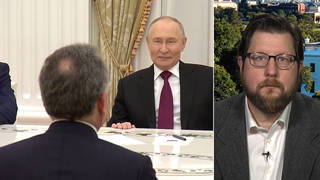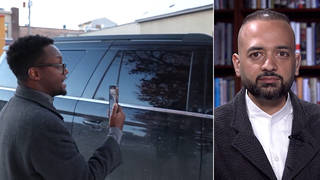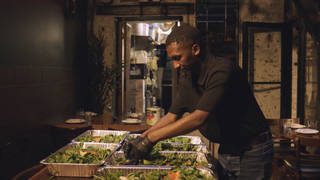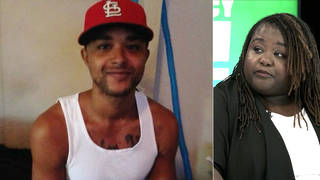
Guests
- Michael Bellfather of Michael Bell Jr., a 21-year-old killed by the Kenosha police in 2004.
In light of the police shooting of unarmed African American father Jacob Blake, we look at the past misconduct of the Kenosha Police Department. In 2004, Kenosha police killed white 21-year-old Michael Bell in front of his mother and sister. The Kenosha Police Department conducted its own review of the incident and, within two days, completely exonerated the officers. Bell’s father, Michael Bell Sr., commissioned an independent inquiry that found the police account of the incident to be forensically impossible. “It was really hard for me to believe that a uniformed person would do that,” says Michael Bell Sr., who claims the Kenosha Police Department “covered up the true facts of the case.”
Transcript
AMY GOODMAN: Jacob Blake is not the first victim of a controversial police shooting in Kenosha. Go back some years, on November 9th, 2004, before police body cameras were in use in the United States. Kenosha police killed a white 21-year-old young man named Michael Bell in front of his mother and sister in their driveway.
The incident began when Kenosha police stopped Michael Bell in his car in front of his parents’ home. Bell dashed up the driveway, was grabbed from behind by two Kenosha officers, who pinned him against a parked car. While a third officer kept his mother and sister several yards away, a fourth Kenosha police officer ran up, pulled out his weapon, placed it against Bell’s head and pulled the trigger, killing him. The Kenosha Police Department conducted its own review of the incident and, within two days, completely exonerated the officers.
Bell’s father, Michael Bell Sr., commissioned an independent inquiry that found the police account of the incident to be forensically impossible, suggesting a cover-up. The city settled a civil rights lawsuit with the Bells for $1.75 million, most of which was then spent on a campaign to change Wisconsin’s law governing how police-involved shootings are investigated. After a decade, in 2014, their campaign succeeded, and then-Governor Scott Walker signed the bill into law, making Wisconsin the first state to require outside investigators conduct investigations into police shootings.
That’s where the Jacob Blake investigation is right now, under the supervision of the Wisconsin Department of Justice with involvement of the FBI, Wisconsin State Patrol and Kenosha County Sheriff’s Office.
For more, we go to Kenosha, where we’re joined by Michael Bell’s father, Michael Bell Sr., who led the campaign to change the law.
Welcome to Democracy Now!, Michael Bell. This must be horrifyingly familiar to you. While you have Jacob Blake laying handcuffed in a hospital bed as a result of being shot by white police officers seven times at point-blank range in the back, you must have gone through a lot of déjà vu in the last days with your family. Tell us the story of your son Michael.
MICHAEL BELL SR.: Well, first, thanks, Amy, for having me on your show. I want everybody to know that I am a retired military officer. I was a pilot. And so I’m coming at it from that perspective. I flew combat missions in three different conflicts for our country. So, when my son first got killed, it was really hard for me to believe that a uniformed person would do that, because everybody that I was associated with would never have done something like that. It was really sad that I didn’t even believe my own daughter’s version of it. It took me about 10 weeks or so before I understood the truth, just because I was just so hardened as a pro-uniform type of person.
My son had come home from a night out with friends, had pulled in front of his own home. You can go to MichaelBell.info, and you can watch the dashcam video. An officer who he had a run-in with just weeks before pulled up. My son was not a perfect angel. He did have a pending DUI. Also, he was a college student, and he was employed. So, essentially, this officer approached him, and it wasn’t even in a nice manner. It was essentially, “Get back in the car. Get back in the car.”
My son, he worked with the officer. He started moving back to the car. The officer saw somebody in the front seat, and he pulled my son off camera then and didn’t put him in a car. Very quickly, the officers made some accusations, which turned to be false. He accused my son of speeding and running a stop sign. But you can see the dashcam video, and also in the civil rights trial we negated that, all those claims.
Eventually, my son refused a breathalyzer. An officer went to arrest him. They tased him. You can hear him scream. He ran to the back of the home. And Michael’s mother and sister heard the commotion. They ran downstairs. And also a number of other people turned on their porch lights to watch what was going on. And my son was — my son was essentially bent over a car and handcuffed, and an officer screamed, “He has my gun!” And an officer arrived on the scene, placed his gun directly to my son’s temple. He tried to fire it, but because the slide was disengaged, the gun wouldn’t fire. So he put it back to my son’s temple a second time, and he fired a deadly shot.
AMY GOODMAN: The officer in charge gave him a direct command?
MICHAEL BELL SR.: Yes. “Shoot.” And I have to tell you that I have investigators on my team that are retired police officers, and we’ve later uncovered that the officer who said, “He has my gun,” had made an honest mistake. He had backed himself up into a car mirror. The car that was in question here was a Nissan Pulsar and had a very thin driver-side mirror, and it fit perfectly between what was called the jacket gap. In Wisconsin, the winters are kind of cool, and so the holsters are set up in such a way that your gun can remain on the outside of your jacket. And it kind of looks like a hook on top of a cane.
Well, this officer backed into this mirror, and as he twisted, he felt the tugging on his gun, and he immediately called out, “He has my gun.” And that’s when the problem occurred. Now, I understand, as a military officer, that types of things like this occur in combat situations that are highly volatile. But the problem that I had was this, is that the Kenosha Police Department covered up the true facts of the case. And in addition to that, those facts are ongoing today, and this investigation is not over with. We are looking to find the truth about my son’s case, and that’s why we’re still pushing it.
AMY GOODMAN: So, you have the police officer who you believe his holster was pulled. He was up against the driver’s side outside mirror. Then you have the police officer who had Michael in a bear hug. And you had this all described, because his mother and sister was right there being held back by a fourth officer. And this third officer, you believe, came in between Michael being held in a bear hug over the hood of the car and this officer, who thinks Michael has his gun but in fact it’s the mirror that has his gun. And this officer comes in between them and puts the gun to his head, because he’s shot in the right side, in the right temple, and pulls the trigger.
MICHAEL BELL SR.: That’s absolutely correct. And we knew that from early on. And it took us several years to finally catch them. In 2007, under video depositions, my attorney, Patrick Dunphy at Cannon & Dunphy, he allowed all the officers to tell their lies. And after the fourth officer told the lie, Lieutenant Krueger, he handed him a copy of the forensics examiner’s report that showed that my son was shot in the right side of the head and the bullet exited the left side of his head. And then they were caught. And then they turned around and tried to recreate a different version where the officer was placed in the front of the car and they had to twist my son’s head around.
I want your listeners to understand that the police in Kenosha had changed their testimony 19 times. Eyewitness testimony never changed once. The officer who killed my son actually changed his testimony six times. And so that’s the problem that’s going on right now here in Kenosha, is that even though we fought for an independent investigation, all that investigation is going to go back to a district attorney who has been ignorant of all the facts of the Michael Bell case. And so, I am very worried about whether justice is going to be served in the Jacob Blake case.
AMY GOODMAN: So, I’m going to talk about that in a second, where this Jacob Blake case is right now, who’s doing the investigation. But take us a step further. Michael is killed in 2004. You have your own investigation done, an independent investigation, completely conflicts with the police investigation that exonerated all the officers. Then, in 2010, talk about the officer who took his own life.
MICHAEL BELL SR.: We settled a civil rights lawsuit on Michael’s birthday in 2010. And it is our belief that — when I settled the civil rights lawsuit, it was a record lawsuit at the time. I refused to accept a nondisclosure or confidentiality agreement. It was important to me to make sure that Michael’s story was told and these facts can continue to come into the public. Well, the city was under such pressure at the time to settle that they accepted under those conditions.
And later in the summer, I started taking out billboards along interstates in Wisconsin, and those billboards said, “When police kills you, they investigate themselves.” And word got to the officer that the case was still open. And October 30th of 2010, the officer who mistakenly said that Michael had his gun took his own life. And that’s the sad part about it. I want your listeners —
AMY GOODMAN: Say that again?
MICHAEL BELL SR.: That’s the sad part about it, is that the officer that hooked his gun on a car mirror took his own life on October 30th, 2010. And I want your listeners to understand that there’s tragedy on both sides of this, that the families of officers are grieving, that officer Erich Strausbaugh’s two children are growing up without a father. Our family is devastated by this.
And that is why I am unrelentingly challenging the current system. And we accomplished the first part of that in 2014 by passing a law that says police cannot investigate themselves after a fatal deadly shooting. And just this week, we are getting ready to introduce new legislation which is a second part of our journey forward.
And I want everybody to remember that I’m a military pilot, and flying jets in combat scenarios is very dangerous. And the way we stay alive is by investigating previous mishaps thoroughly, understanding the true root causes and then implementing safety recommendations to make sure that it doesn’t happen again. I wrote an article — and your listeners can look for it — it’s called “The Insanity of Finding Fault Versus Fixing Cause.” And what I did is I took an airplane crash, and I also took a police shooting, and I compared them side by side, and I showed how one changed aviation forever for the better, and the law enforcement side, nothing changed. And that’s why we are in this continuing cycle. So —
AMY GOODMAN: So —
MICHAEL BELL SR.: — in 2007 — go ahead.
AMY GOODMAN: So, Michael Bell, I just want to ask — the law you got passed in 2014, and this bears directly on Jacob Blake’s case —
MICHAEL BELL SR.: That’s right.
AMY GOODMAN: The law you passed took an investigation of an officer-involved shooting out of Kenosha, and the attorney general of Wisconsin is now in charge of it. But when I watched that news conference on Wednesday, it was then explained that once they do the investigation — maybe it takes, what, 30 days — they then go to — they send that information back to the DA, and he does like a thumbs up or a thumbs down: Is there enough evidence here to convict? He decides that, the Kenosha DA.
MICHAEL BELL SR.: And that’s right. And the Kenosha DA has been a thorn to this from the beginning. I mean, you have all this changing testimony. You have forensically impossible facts on my son’s case, and the Kenosha DA turns a blind eye to it. And I am very worried that the Kenosha DA is going to do that same thing with Jacob’s case. I have been telling everyone that we should be doing like New York and New Jersey. The governor of New York did an executive order that said that all police shootings have to be prosecuted by outside prosecutors. So this case does not need to come back to a DA that has a long-term relationship with both the Sheriff’s Department and the Police Department.
I’m going to be releasing a video very soon that shows that the DA, Michael Graveley, here in Kenosha, colluded with the police chief to block an investigation into [Daniel] Miskinis’s department. And so, that’s one of the things that has to change. We cannot have local police shootings investigated by the local prosecutor whose political base is the families and relatives of the law enforcement officers that he provides cover for.
AMY GOODMAN: And finally, as Jacob Blake was shot at point-blank range seven times in the back with his little kids — 3, 5 and 8 — watching in horror in the car, when you learned of this, Michael Bell, your thoughts? And do you know Jacob’s family?
MICHAEL BELL SR.: I do not know Jacob’s family. I learned about it Sunday night. We have a Facebook page, Plea for a Change, and people from that Facebook page were just sending me video after video. And so, during the dinner table, first thing I did is I opened up and watched the video, and I was very appalled by what I’ve seen. But I’m not rendering judgment until the investigation is complete.
But one of the things that my eyes were drawn to immediately was the woman that was standing outside the door of the car jumping up and down, because I know how emotionally traumatic this is to a family member that has to see it. I assure you that even though my son’s case was 16 years ago, Michael’s mother, Michael’s sister and the eyewitnesses that saw that case are still traumatized by the events of that night.
AMY GOODMAN: Well, Michael Bell, I want to thank you so much for being with us, father of Michael Bell Jr., 21-year-old young man killed by the Kenosha police in 2004. It is his father’s efforts that led to the change in the law that took the investigation of an officer-involved shooting out of the hands of the Kenosha police.
When we come back, President Trump accepts the Republican presidential nomination again in a speech filled with lies and falsehoods. We’ll air excerpts and speak with the historian Rick Perlstein.












Media Options